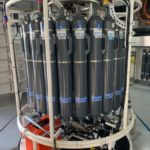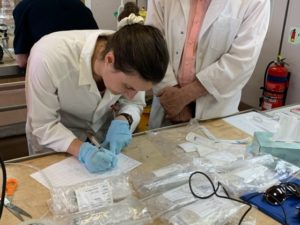Day 4: Friend or Foe? The Hitch Hikers
While on board I helped researcher Elise Tuuri from Flinders University collect bacteria samples. The Niskin Bottles collected samples of sea water off the coast of Broome at three different depths. This piece of scientific equipment is made up of 24 large cylinders around a metre in length that are arranged around the outside of a metal frame.

The Niskin Bottles on the RV Investigator.
The CTD (Conductivity, Temperature, Depth) deployment is called a cast and is done when the ship is at a standstill over a designated site. The CTD deployment is done from the side of the ship by a mechanical arm that carefully lowers all of the Niskin Bottles into the ocean.
Elise will use these samples to discover what bacteria is present in the water so that it can be compared to the bacteria that might be found on microplastics pulled from other samples in the EZ Nets.
It’s vital to understand the transportation and abundance of small plastics in oceans around Australia and whether the hitch-hiking bacteria is a vector for disease amongst our fish populations or something that is present in our water already. The preserved bacteria samples will be sent from Fremantle to Flinders University to be analysed further by Elise.

Elise Tuuri analysing samples.
